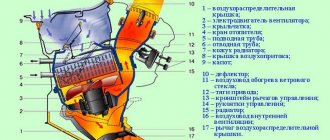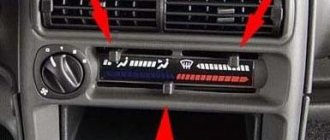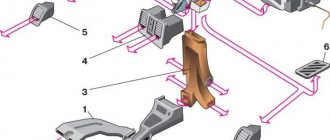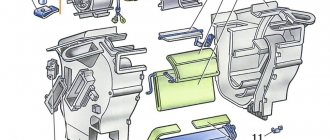Every fall, a good car enthusiast thinks about preparing his car for winter. Particular care should be taken when preparing the VAZ 2107 stove, which should heat the car well. The heating system fails for various reasons, and if you don’t pay attention to it in the summer, then in the winter, with severe frosts, all the windows will freeze and fog up from the inside, and driving such a car will become dangerous, and maybe even completely impossible.
It is necessary to know the structure of the stove well so that in winter you do not have any unpleasant surprises with heating the interior.
Stove design
The stove consists of the following parts:
- Heater, a stove radiator is installed in it (indicated by the number 5 in the figure), it heats the air penetrating from outside;
- The stove fan, or motor (indicated by the number 14 in the figure), it pumps a flow of warm air into the cabin, it is mounted in a special casing (indicated by the number 16 in the figure) on elastic cushions that dampen its vibration;
- The stove control system is a fan button (indicated by the number 18 in the figure), three control knobs for heating modes - blowing onto the windows, taking air from the cabin or from the street, and opening and closing the stove tap.
1, 9 – air ducts for heating the side windows on the left and right; 2 — air duct for heating the windshield; 3 — radiator casing; 4 — air intake cover; 5 — heater radiator; 6 — radiator valve; 7, 8 radiator hoses for supplying and discharging hot fluid from the cooling system; 10 — rotary deflectors; 11 — air duct damper; 12 — air distribution cover; 13 — fan guide casing; 15 — lever of the air distribution cover; 17 — control rods; 19 - central air duct.
The heating system works in the following order:
- Air for heating comes from outside, through air intakes on the hood.
- Under the hood there is a special box, insulated with a rubber seal, for air flow.
- From it the air flow is directed to the stove.
- Next, the air is heated by a radiator, which is fed with antifreeze and antifreeze. The degree of heating is regulated by the heater tap. The faucet is controlled by a flexible rod using a control lever.
- At high vehicle speeds, air can enter the passenger compartment without the fan being turned on. Therefore, at high speed you can use the stove without additional load on the car’s electrical network. The interior heater is turned on by a fan switch that has three positions - neutral and two speeds: low and high. Speeds are provided by a resistor; it increases the resistance of the circuit and reduces the speed of the fan.
- The fan accelerates the warm air flow through the air ducts to the sides, onto the side windows for good visibility of the rear-view mirrors, and into the grille deflectors, which can change the direction of the air flow for better airflow. There is also a flow of warm air through the air duct to blow on the windshield.
Above in the figure, blue shows the circulation diagram of cold air flows, and orange shows the movement diagram of warm air flows. Main parts of the heating system:
1 — air distribution cover; 2 – fan electric motor; 3 – fan, impeller housing; 4 – heater tap; 15 – radiator.
The stove is controlled:
- Changing the position of the lower cover of the fan casing using a lever (down-up);
- Changing the position of the control unit levers (heating flaps of the side windows and windshield, air supply covers).
What breakdowns most often occur in the heating system?
- Leaking radiator tap, pipes, radiator housing;
- Malfunction of electrical equipment (fuse, mode switch, oxidation of wires, motor). The fan fuse is located in the mounting fuse block numbered F1 with a rating of 10A; below is a diagram of the mounting block.
Replacing the stove faucet
On a VAZ 2107 car, sometimes the faucet may leak or even become sour. They have to be used intensively and therefore often fail. Before you start replacing the faucet, purchase a set of gaskets for it. The tap is changed when the engine has cooled down.
Replacement sequence:
- Loosen the clamp of the inlet pipe (lower) and remove it from the tap;
- Use the lower lever in the control unit to close the dampers;
- Remove the glove compartment;
- We dismantle the air duct behind the glove compartment - to do this, disconnect it from the side deflector and remove it from the heater housing. Now, using a 7 key, loosen the crane rod and remove it.
Using a 10mm wrench, unscrew the valve from the radiator;
Control module
The heating system of the VAZ-2107 is controlled using a special module located at the bottom of the dashboard. Its design includes three levers and a heater fan mode switch.
The topmost lever controls the “stove” tap. In the extreme left position it is closed, and the coolant flows bypassing the heating radiator. If the switch is moved all the way to the right, the refrigerant will begin to flow into it in full, heating the air to the maximum.
The middle lever allows you to close and open the air supply cover. In the left position it will be completely closed and outside air will not be able to enter the cabin. The lid will open completely when we move the switch to the far left position.
The heating system of the VAZ-2107 provides for the distribution of air flows for blowing the windshield and front side windows. This is done using the lower lever. In the right position, the air is directed to the side windows, in the left - to the windshield.
The heater valve, air supply cover, as well as dampers that redirect air flows are driven by cables.
The fan mode switch is located to the left of the control levers. It has four positions in which the fan:
- switched off;
- works at first speed;
- at second speed;
- at third speed.
How to make the stove heat in a VAZ: Video
A heating system that uses the heat of the coolant is responsible for heating the interior of the VAZ 2107. This scheme, recognized as optimal for cars with internal combustion engines, has been used in cars since the mid-20th century.
Like any car component, the VAZ 2107 stove may stop working. In winter, such a breakdown makes the car impossible to operate: the windows sweat or become covered with frost, which impairs visibility. For effective repairs, you need to have a good knowledge of the interior heating system.
Design and operation of the VAZ 2107 heating system
The system includes the following components:
- Heater VAZ 2107, whose task is to heat the air. The main element of the heater is the radiator, through which coolant circulates.
- A fan that directs heated air into the cabin. It is attached to the casing using elastic pads that dampen vibration.
- Heater control system, including a fan button, handles and dampers for the heating mode control system.
The heating system works like this:
Through the grilles on the hood, air enters the air supply box located in the engine compartment near the windshield.
In the event of rain or downpour, the water is separated from the air and flows into the holes in the box. This allows you to use the stove in any weather, but until the radiator heats up, the air entering the cabin during rain will be damp.
The air flow is directed to the VAZ 2107 heater and heats up as it passes through the radiator. Heating is regulated using a tap, which regulates the amount of coolant passing through. The crane is controlled by a flexible rod attached to the control lever.
While driving, the air flow enters the engine compartment and the air independently enters the heater. When stopping or at low speed, an electric fan is used, controlled by a switch that has three positions: “off”, “full speed” and “low speed”. Reduced speed is achieved by turning on the electric motor through a resistor, which reduces the voltage on the motor winding.
After the radiator, the air enters the air ducts and exits through deflectors, which allow you to change the direction of flow. Warm air can be directed onto the windshield and side windows, under the feet of the driver and front passenger.
Control elements of the air flow from the VAZ 2107 stove:
Before repairing the VAZ 2107 stove, it is necessary to understand the causes of the malfunction.
Interior ventilation
Outside air can enter the vehicle interior:
- with the door windows down;
- through the upper nozzles on the instrument panel, if you move distribution lever 7 (Fig. 9) and lever 6 for controlling the air supply hatch cover to the right;
- through the side nozzles 1 on the instrument panel, if you move lever 6 to the right and lever 7 to the left;
- through the holes of the heater casing, if you open the heater cover with lever 9 and move lever 6 to the right;
- through the central nozzles 4 directly from the air supply box when the car is moving, if the regulators 2 open the nozzle flaps (summer airflow).
By moving lever 3 in the horizontal and vertical directions, the direction of the air flow from the nozzle changes.
In the middle position of lever 7 and in the right extreme position of lever 6, air will flow through both the top and side nozzles.
If the vehicle is moving at low speed, you can increase the amount of incoming air by turning on the electric heater fan with switch 10.
Malfunctions of the VAZ 2107 stove and how to eliminate them
If the VAZ 2107 stove does not heat up and when the heater is on, the air leaving the deflectors remains cold, the reasons may be as follows:
- Airing the cooling system. This can happen when replacing antifreeze or repairing cooling system components. To restore heating, you need to remove the air plug.
- The heater valve in the open position continues to shut off the line. The reason for this is a clogged faucet or the formation of scale in it due to the use of water in the system instead of antifreeze. To restore the heater's functionality, the tap must be removed and then cleaned or replaced with a new one.
- The stove remains cold when the tap is open. The cause of this phenomenon may be a non-working pump. This breakdown quickly makes itself known through rapid overheating of the engine; it is impossible not to notice it. If the engine is warmed up to operating temperature, and the pipes leading to the VAZ 2107 heater remain cold, the pump needs to be repaired. One of the reasons why the pump will not work is a slipping or broken alternator belt.
- The air is cold and the supply hose is hot. This is a common problem resulting from clogged radiator honeycombs. They can become clogged due to scale build-up, oil in the antifreeze, or the use of “leak stop additives.” In this case, the VAZ 2107 stove must be dismantled and washed.
- The radiator pipes are hot and the air is cold. This occurs when a baffle in the radiator moves and creates a straight path between the inlet and drain pipes. You can restore functionality by replacing the radiator.
Another type of breakdown is an antifreeze leak. This manifests itself in the appearance of condensation on the windows or leakage of antifreeze into the passenger compartment under the feet of the passenger and driver. The reasons here are:
- Antifreeze is leaking through the heater valve. In this case, it can be replaced without removing the radiator.
- The leak occurs through a burst pipe. The solution is to replace the pipe with a new one.
- The heater radiator is leaking. In this case, repairing the VAZ 2107 stove involves soldering or replacing the radiator.
Reasons for decreased performance
In addition to obvious malfunctions due to which the stove does not work or functions incorrectly, there are other problems with the heating system of the VAZ-2107 interior. The main one is a decrease in stove performance.
If the stove heats poorly, then the reason lies in:
- Malfunctions of the power plant cooling system (reduced pump performance, stuck thermostat).
- Radiator clogged.
- Formation of an air lock in the heater radiator.
- The air intake damper seal is worn out.
To find the cause of decreased performance, start by checking the heating of the heater radiator. To do this, heat the engine to operating temperature, fully open the antifreeze supply valve to the stove and hand check the degree of heating of the supply pipe before and after the valve and the radiator itself. If the pipeline is hot before the tap, but not after it, the tap is jammed. If the radiator does not warm up, the reason lies in severe clogging of the heat exchanger or a plug in it. If the pipeline does not warm up even to the tap, inspect the cooling system.
If the radiator warms up well, but it is noted that the stove heats worse, then check the functionality of the air intake damper and the condition of its seal. It wouldn’t hurt to check the stove body and air ducts for leaks and cracks.
Dismantling the heating radiator VAZ 2107
To do the job you need a Phillips screwdriver and a set of wrenches (open-end and socket).
- loosen the heater hose clamps located in the engine compartment;
- remove the hoses from the heater radiator pipes (this may result in a slight leak of antifreeze);
- unscrew the screws securing the rubber seal;
- remove the seal;
- unscrew the radio panel;
- disconnect the cable from the tap of the VAZ 2107 stove;
- Using a screwdriver, remove the brackets on the fan casing;
- lower the casing down;
- remove the heater radiator.
Repair of heating radiator VAZ 2107
Often, repairing a VAZ 2107 stove involves replacing or repairing the heater radiator. Repair actions depend on the type and cause of the malfunction:
A clogged radiator can be flushed with water pressure. Scale on the walls of honeycombs can be removed using a special product that dissolves it.
A leak in a copper (brass) radiator can be soldered. Using a powerful soldering iron and solder, you can repair a hole or crack. Leaking aluminum radiators must be replaced.
Important: to eliminate a leak in the heater radiator or engine cooling system, you should not use products added to antifreeze - they can cause clogging of the VAZ 2107 radiator honeycomb.
Replacement result
After replacing the heater tap, check its operation by turning on the fan, opening the air intake damper completely, and opening and closing the flow of coolant into the heater radiator. When the flow is blocked, the temperature of the discharge air should drop significantly.
If there was a leak from the faucet before the repair, wipe the inside of the windshield with an alcohol solution to remove deposits and dry the carpet.
Now you can fully regulate the climate in the cabin, and not worry about a coolant leak, at least for some time.
Heater assembly VAZ 2107
The repair of the VAZ 2107 stove is completed by assembling the heater. They assemble it in the reverse order of disassembly. The work has a number of features:
- rubber gaskets must be replaced with new ones and lubricated with silicone sealant;
- before assembling the heater, it is necessary to attach the pipes and tap to the radiator;
- Do not overtighten the nuts so as not to crush the gaskets;
- before putting on the rubber hoses, the outer surface of the metal radiator pipes must be treated with sealant;
- After the VAZ 2107 heater is assembled and connected, you must remember to add antifreeze to the system and check its tightness.
Important: repair of the VAZ 2107 stove must be carried out in conjunction with checking the serviceability of the engine cooling system components. This approach allows you to accurately determine the cause of the breakdown and reliably eliminate it.
Replacement instructions
Repair of the heater tap consists of replacing it. This is not a complicated procedure, so the repair can be done at home.
To carry out the procedure, you need to prepare the tools and necessary materials:
New part for the stove When deciding which faucet is better, a ceramic one or a metal one, it is better to purchase a product with a ceramic locking mechanism. It meets all requirements for throughput and fastenings. In addition, it will last a long time, since ceramics are not subject to oxidation processes.
To make repairs more convenient, it is better to install the car on an inspection groove or drive it onto an overpass or lift.
Dismantling the heater valve. Replacing the VAZ 2107 heater valve is carried out in stages:
Tuning the VAZ 2107 stove
You can improve the VAZ 2107 heater by installing an additional fan to increase the air flow to the windows. Another common type of tuning of the VAZ 2107 stove is replacing the fan mode switch with a button.
Before the onset of cold weather, every responsible driver carries out a preventive inspection of the car and eliminates possible malfunctions. Most often, oil and antifreeze are changed regularly, and the car tires are changed to winter ones. The stove, which is one of the main units of the car, which provides comfort for the driver and passengers in the cold season, also requires special attention.
This article will discuss the design of the VAZ-2107 stove and its correct configuration for high-quality heating of the interior.
The design and principle of operation of the VAZ-2107 stove
In order to carry out preventive maintenance of the heating system of the vehicle interior and correctly configure its operation, you must first understand the structure of the VAZ-2107 stove.
The stove in the seven is located in the cabin and is attached to the partition of the engine compartment with four fasteners. A rubber seal is installed between the motor and the stove. Air arrives to the stove through special holes in the hood. At the rear of the heater in the engine compartment there is an air supply box. The air passes through the radiator, where it is heated, and enters the car either under the pressure of cold air from the street at high speeds of the car, or under the action of a fan, which creates air movement under pressure. The fan has three operating speeds: neutral, low and high. The fan speed switch is located on the dashboard of the car.
The heater radiator uses liquid from the car's cooling system to function. The amount of hot liquid that enters the radiator can be adjusted using the tap. It is located near the floor of the vehicle on the passenger side and comes from the flexible rod control lever. The control lever is located on the dashboard of the vehicle. The top heater switch controls the heater tap. In the extreme right position, the switch fully opens the tap, allowing the maximum possible amount of coolant to enter the radiator. In the switch position on the left, the tap is closed, antifreeze does not enter the radiator, and the stove remains cold.
The heater motor is located under the radiator. A resistor is included in the electrical system of the motor, which makes it possible to switch fan speeds.
Under the action of the fan, warm air flows through the tubes towards the side windows, to the windshield and to the deflectors. Using deflector grilles, you can change the air supply route for directional airflow. Hot air is controlled by opening or closing the stove damper, the lid of which is adjusted by flexible rod levers. The middle lever is responsible for closing the air supply hatch. In the extreme right position of the switch, the maximum possible amount of air from the street enters the car. In the extreme left position and the lid is tightly closed, air does not enter the cabin.
Anti-fog protection for windshield, front door glass and rear window
To protect the windshield and front door windows from fogging, it is enough to direct cold air onto them, for which:
- close the heater cover with lever 9;
- move lever 6 to the right, and set lever 7 to the middle position;
- Install the guide vanes of the side nozzles so that the air flow is directed towards the front door windows.
If you need to warm up the incoming air a little, move lever 5 of the heater valve control partly to the right. If necessary, turn on the electric heater fan.
To protect the rear window from fogging, turn on its electric heating with switch 8.
Common stove malfunctions and options for eliminating them
Before the onset of cold weather, it is imperative to check the functioning of the main elements of the VAZ-2107 heater.
Most often, the following malfunctions occur in the interior heating system of the seven:
- Poor quality connection of pipes and air supply pipes.
- Radiator and heater tap leaking.
- Malfunction of the electrical equipment of the stove - oxidation of the wires, failure of the motor or fuse of the stove. The fuse is located in the block under the hood of the car. The fuse box is located on the partition between the passenger compartment and the engine compartment on the passenger side.
Even a novice driver can fix such malfunctions in the heating system. More serious breakdowns may lead to the need to purchase a new stove.
First you need to conduct a visual inspection of the heating system parts. To do this, you need to disassemble the stove and clean it of particles of debris and dust collected over the summer.
One of the most common problems in the heating system of the VAZ-2107 is poor-quality sealing of the stove air ducts. This problem can be eliminated by treating the cracks in the plastic elements of the heater housing with silicone. Also, the holes near the pipes must be sealed with rags. Eliminating the holes will reduce the loss of warm air and will result in faster heating of the interior.
The next step is to check the heater and radiator valves for leaks. This is the main headache for owners of domestic cars. If the stove faucet or pipes are leaking, they must be replaced with new products. At the same time, the sealing butt gaskets are also changed. If the radiator itself is leaking, then there are two options for solving the problem. Most often, sevens have an old-style copper radiator installed. A copper radiator can be soldered and thus extend its life. If the seven is equipped with an aluminum radiator, then it cannot be repaired and must be replaced with a new product.
If, after carrying out all the preventive manipulations, cold air enters the cabin, the reason may be a clogged radiator, then it will need a thorough cleaning. Experts recommend carrying out preventive radiator flushing at least once a year. At the same time, all hoses and pipes are washed.
For preventive purposes, it is important to inspect the stove wiring for oxidation or poor contact insulation in order to avoid short circuits, burnout of the motor and heating system fuse. If the stove is working, then a visual inspection and troubleshooting is sufficient. Otherwise, it is necessary to check the functioning of the electrical circuit elements using a tester.
Such simple manipulations will save you from unpleasant situations with the heating system during the cold seasons.
How to identify the problem and fix it
There are several reasons why the furnace blows cold air or does not work at all. In this case, you must proceed as follows:
- Check the faucet to see if it opens.
- Is the cold air damper capable of closing?
- With the car running, check the heater (heater radiator) for heating.
Radiator replacement
If the problem is in the radiator and it needs to be replaced, then proceed as follows:
- Drain the liquid.
- We unscrew the two clamps from the engine compartment, which are located on the radiator pipes. We remove the hoses.
- Unscrew and remove the fasteners on the rubber seal.
- We dismantle the radio panel and the cable fasteners on the heater valve drive. To do this job you will need a 7 key.
- Next, use a screwdriver to remove 4 spring clips from the fan casing. The casing drops down and slides to the left, after which the radiator can be pulled out.
- Now you can carefully examine the radiator, revive it or replace it with a new one. Assembly is carried out in the reverse order and does not involve any difficulties.
A broken radiator is a common cause of a non-functioning stove.
Restoring glass blowing
The stove that is installed on the VAZ-2107 has some design features, due to which the left pipe often does not blow the glass well enough. To put up with such an inconvenience in winter is difficult. Therefore, it is worth working to eliminate this problem. You must proceed according to the following scheme:
- We remove the deflector from the pipe by prying one of its sides with a screwdriver.
- The deflector body is held on the torpedo using small antennae. We put our hand inside and pull it out.
- The 50mm fan from the computer must be placed in the center of the dismantled case and marked in the appropriate places.
- In the plastic case, using a utility knife, hacksaw or sharp knife, cuts are made at the marks.
- The plastic easily breaks off along the line of cuts and an opening is obtained into which the fan is installed. It should fit snugly in place.
- We return the insides of the deflector to their place. The internal blades will not be able to rotate at full speed due to the changes made.
Other minor faults
Finding and fixing minor problems on your own is a handy skill for any car enthusiast.
After such actions it will be easy to determine the causes of the breakdown. And they can be as follows:
- If the faucet is working properly, but the heater heats up only at high engine speeds and under such conditions begins to blow warm air, then the fault should be looked for in the pump or a coolant leak. To find a leak, you must carefully examine the required area of the cabin. If leaks are found, the hoses need to be replaced, tightened or new clamps installed. Do not neglect the cap on the expansion tank. Tightness is the main condition under which the heater can function normally.
- Leaks can also occur due to rusting of the radiator, taps and other elements of the heating system. In this case, it is enough to simply replace the necessary part and enjoy a comfortable ride.
- The tightness can be checked in another simple way. Turn on the engine and wait 10 minutes. During this time, the expansion tank should warm up. If this does not happen, then we can talk about the lack of pressure that is necessary to supply antifreeze or antifreeze to the heater stove.
- If you notice that the car gets very hot when standing in a traffic jam, then you can talk about the lack of necessary pressure.
- The stove can become clogged with various debris and become coated from the inside with oxides of various substances. In this case, it is necessary to clean out the debris and clean the system.
The car owner must be prepared for minor problems and be able to quickly fix them. For example, with the onset of winter, many VAZ-2107 owners’ stoves do not heat up and it is not always convenient to run to specialists with this problem.
Stove modernization
Very often, in parallel with the prevention of stove malfunctions and its settings, the driver modernizes the heating system for more efficient operation.
Most often, for these purposes, the standard fan and resistor are replaced with products from the figure eight. The new fan is larger in size, due to which a larger amount of warm air is supplied, and the vehicle interior warms up faster. The new fan fits into the standard seat with virtually no modifications. It is only necessary to cut off one of the aerodynamic ridges from the impeller. After such improvements, it will also be necessary to replace the standard fan button with a product from the figure eight.
Sometimes, for better airflow of the driver’s side windows, additional small fans are installed in the deflectors. Such improvements, combined with preventive maintenance, will ensure comfort and warmth in the cabin even in the coldest times.
Let's sum it up
Timely diagnostics, preventive cleaning and inspection of elements of the vehicle’s heating system is a guarantee of high-quality operation of the stove. Experts recommend checking the heating system on the VAZ-2107 at least twice a year - in autumn and spring. Any driver can handle preventive cleaning and adjustments of the stove on his own; to do this, you just need to understand the structure of the heating and ventilation system of the cabin and the principle of its operation. The easiest way to do this is to always have a visual instruction manual for your car nearby.
Don’t put off any further work to improve the functioning of your car’s heating system. Proper care will ensure uninterrupted operation of the heater and a comfortable temperature in the interior at any time of the year.











